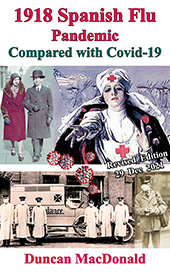Bacterial Infections |
Duncan MacDonald
Jakarta 10 March 2007
Reviewed 18 February 2022
Bacteria entering the body causes a large group of diseases. The bacteria multiply too fast to be destroyed by the immune system. Some types of bacteria also release powerful poisons, known as toxins that rapidly damage tissues.
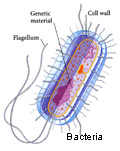
In the past bacterial diseases were a major cause of death; today most serious infections can be treated with antibiotics. [1]
Typhus A serious rickettsial infection transmitted to humans by lice, fleas or mites. Caused by living in overcrowded unhygienic conditions. There are 3 main types of typhus, all of which are caused by different types of rickettsial bacteria.
Epidemic typhus is transmitted by body lice, usually in overcrowded conditions and has resulted in hundred of thousands of deaths inn times of war or famine. Today the disease is rare except in some tropical areas of Africa and South America.
Endemic or murine typhus, is rare and is transmitted to humans from rats by fleas.
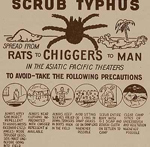
Scrub typhus is transmitted by mites has been reported in South East Asia and India.
The first sign of infection with scrub typhus is a black scab over the site of the bite. In all types of typhus, flu-like symptoms may develop in 1 – 3 weeks of infection, followed a few days later by a widespread blotchy pink rash. In severe cases, delirium and coma occur. If the disease is not treated dangerous complications such as pneumonia or kidney failure are likely to develop.
Diagnosis is from symptoms or by blood test. Treatment with antibiotics is usually effective. Without treatment the disease can lie dormant in the body for years before being reactivated.
Typhoid and Paratyphoid Infections caused by salmonella bacteria that result in high fever followed by a rash.
Typhoid and paratyphoid are almost identical caused by the bacteria Salmonella typhi and S. paratyphi respectively. The bacteria multiply in the intestines and spread to the blood and other organs, such as the spleen, gallbladder and liver.
The disease is spread through infected faeces and most commonly occur in areas where hygiene and sanitation are poor. Infection is commonly due to food or water contaminated by unwashed hands.[ 2 ]
Symptoms appear 7 – 14 days after infection and include;
• Headache and high fever
• Dry cough
• Abdominal pain and constipation usually followed by diarrhoea.
• Rash of rose coloured spots appear on chest, abdomen and back.
Both infections can lead to intestinal bleeding and perforation of the intestines.
Diagnosis is by testing blood or faecal samples. The disease is usually treated by antibiotics in hospital. Symptoms usually subside in2 – 3 days after treatment is begun and full recovery within a month.
Even with treatment the bacteria are excreted for about 3 months. People who do not have treatment may become lifelong carriers of the bacteria, even though they appear to be healthy, and transmit the infection to others.
 Typhoid Mary aka Mary Mallon (born: 23-Nov-1869 died: 11-Nov-1938), was the first person in the United States to be identified as a healthy carrier of typhoid fever. Over the course of her career as a cook, she infected 47 people, three of whom died from the disease. Her fame is in part due to her vehement denial of her own role in causing the disease, together with her refusal to cease working as a cook. She was forcibly quarantined twice by public health authorities and died in quarantine.
Mallon died at the age of 69 due to pneumonia (not typhoid) after a stroke six years earlier which left her paralysed. However, an autopsy found evidence of live typhoid bacteria in her gallbladder[ 3 ]
Typhoid Mary aka Mary Mallon (born: 23-Nov-1869 died: 11-Nov-1938), was the first person in the United States to be identified as a healthy carrier of typhoid fever. Over the course of her career as a cook, she infected 47 people, three of whom died from the disease. Her fame is in part due to her vehement denial of her own role in causing the disease, together with her refusal to cease working as a cook. She was forcibly quarantined twice by public health authorities and died in quarantine.
Mallon died at the age of 69 due to pneumonia (not typhoid) after a stroke six years earlier which left her paralysed. However, an autopsy found evidence of live typhoid bacteria in her gallbladder[ 3 ]
Boil it, cook it, peel it or forget it
◊ If you drink water, buy it bottled or bring it to a rolling boil for 1 minute before you drink it. Bottled carbonated water is safer than uncarbonated water.
◊ Ask for drinks without ice unless the ice is made from bottled or boiled water.
◊ Eat foods that have been thoroughly cooked and that are still hot and steaming.
◊ Avoid raw vegetables and fruits that cannot be peeled. Vegetables like lettuce are easily contaminated and are very hard to wash well.
◊ When you eat raw fruit or vegetables that can be peeled, peel them yourself. (Wash your hands with soap first.) Do not eat the peelings.
◊ Avoid foods and beverages from street vendors. It is difficult for food to be kept clean on the street, and many travellers get sick from food bought from street vendors [ 4 ]
Good hygiene is the best protection against infection. Several vaccines are available and if you intend travelling to a developing country, immunisation may be advisable. However be aware vaccines are not 100% effective.
Typhoid brought down Ancient Greeks
Modern DNA analysis of ancient dental pulp suggests that typhoid fever caused the plague that helped end the Golden Age in Athens. Scientists say the DNA sequences resembled Salmonella enterica servovar Typhi, the organism that cause typhoid fever.
Up to one-third of Athenians are thought to have died from the plague that spread from Ethiopia, Egypt and Libya in 430-426 BCE. One of the most prominent victims was the Athenian leader Pericles.
The plague is thought to have changed the balance of power between Athens and Sparta, ending Athenian dominance [ 5 ]
Cholera An intestinal infection that causes profuse, watery diarrhoea. Cholera typically occurs in epidemics and has caused millions of deaths over the centuries. It is due to the infection of the small intestine by the bacterium Vibro cholerae. Usually associated with poor sanitation, cholera can spread through contaminated water or food.

The illness starts suddenly, 1 – 5 days after infection, with vomiting and profuse watery diarrhoea. In some cases fatal dehydration develops.
Treatment: Cholera is usually diagnosed from the characteristic "rice water" appearance of the diarrhoea. A faecal sample may be checked to confirm diagnosis. Urgent hospital treatment is needed to replace lost fluids and minerals, which are given orally or intravenously. Antibiotics may be given to reduce the risk of passing the infection to others.
Cholera vaccines are relatively ineffective. In regions where cholera may occur, good hygiene is the best protection. Diphtheria A throat infection that causes breathing difficulties. Diphtheria was a common cause of infant death until immunization became routine. In this disease the bacterium Corynebacterium diphtheriae multiplies in the throat and may release toxins into the blood. The infection is usually transmitted through airborne droplets from coughs or sneezes of infected people.
Symptoms develop in 1 – 4 days after infection and include;
◊ Sore throat
◊ Fever
◊ Swollen lymph nodes in the neck
◊ In many cases a grey membrane grows across the throat, causing breathing difficulties
If diphtheria is not treated, bacterial toxins may spread in the blood and cause potentially fatal complications such as acute heart failure and paralysis.
Treatment: Diphtheria may be diagnosed from the symptoms, but a throat swab is taken for confirmation. Most people recover if treated immediately with antibiotics and antitoxin injections. Routine immunization in children and boosters in adults provide protection against the disease.
Leprosy also known as Hansen's disease. An infection that affects nerves and skin,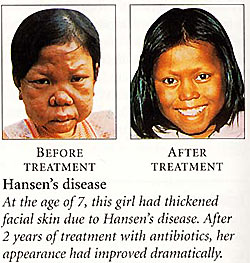 causing numbness and disfigurement. Leprosy is a long-term infection caused by the bacterium Mycobacterium leprae, which damages the skin and nerves. The limbs and face in particular may be affected. Infection is thought to be transmitted by airborne droplets produced when an infected person coughs or sneezes and through skin contact. Contrary to popular belief the disease is not easily transmitted from person to person. Only people who live in prolonged close contact with an infected person are at risk of infection. The disease is most common in Asia, Africa and South America.
causing numbness and disfigurement. Leprosy is a long-term infection caused by the bacterium Mycobacterium leprae, which damages the skin and nerves. The limbs and face in particular may be affected. Infection is thought to be transmitted by airborne droplets produced when an infected person coughs or sneezes and through skin contact. Contrary to popular belief the disease is not easily transmitted from person to person. Only people who live in prolonged close contact with an infected person are at risk of infection. The disease is most common in Asia, Africa and South America.
Leprosy develops very slowly, the first symptoms appearing 3-5 years after infection. Initially nerve damage causes numbness of the skin on face, hands and feet. The affected skin may become thickened and discoloured. Leprosy is only infectious while these early symptoms are developing. Lack of sensation may lead injury or even loss of fingers and toes.
Treatment with antibiotics for up to 2 years prevents further nerve damage and reduces areas of thickened skin. However nerve damage that has already occurred is irreversible.
Plague A serious infection carried by rodents and transmitted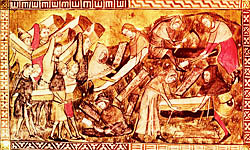 to humans by flea bites. Plague is the result of infection by the bacterium Yersinia pestis. During the Middle Ages the disease caused widespread epidemics, one of the largest was the Black Death of the 14th century, which killed over 25 million people in Europe. Today small outbreaks occur in Asia, Africa and South America and a few cases each year in USA. The plague is unknown now in Europe.
to humans by flea bites. Plague is the result of infection by the bacterium Yersinia pestis. During the Middle Ages the disease caused widespread epidemics, one of the largest was the Black Death of the 14th century, which killed over 25 million people in Europe. Today small outbreaks occur in Asia, Africa and South America and a few cases each year in USA. The plague is unknown now in Europe.
People given immediate treatment with antibiotics usually make a full recovery. However if treatment is delayed, the disease is frequently fatal.
SepticaemiaAn infection also known as Blood Poisoning, in which bacteria multiply in the bloodstream. It affects mainly children and elderly people. It is common for bacteria to enter the bloodstream in small numbers through breaks in the skin or through the mouth when the teeth are brushed.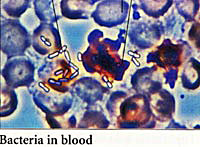
The bacteria are usually destroyed by the immune system and cause no symptoms. However if bacteria enters the bloodstream in large numbers from a major source of infection, such as a kidney infection, blood poisoning can result.
Septiceaemia can develop as a complication of almost all types of serious infectious diseases. The infection is more likely to occur in people with reduced immunity due to disorders as diabetes mellitus or HIV infection, or treatment with chemotherapy.
If you are suspected of having sepacaemia you should be admitted to hospitalfor blood tests to identify the bacterium causing infection. With appropriate antibiotic treatment most people make a complete recovery.
Tetanus A wound infection caused by a bacterial toxin, that produces severe muscle spasms. The toxin causing tetanus is produced by the bacterium Clostridium tetani,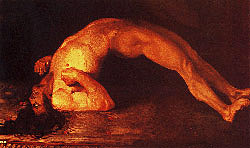 which lives in the soil and in the intestines of humans and other animals. If the bacteria enter a wound, they multiply causing an infection that acts on the nerves controlling muscle activity. The condition, called lockjaw, is rare in developed countries because most people have been immunized.
which lives in the soil and in the intestines of humans and other animals. If the bacteria enter a wound, they multiply causing an infection that acts on the nerves controlling muscle activity. The condition, called lockjaw, is rare in developed countries because most people have been immunized.
Symptoms usually appear 5 – 10 days after infection. Fever, headache and muscle stiffness in the jaw, arms, neck and back are typical. As the condition progresses, painful muscle spasms may develop. In some cases the throat or chest wall is affected leading to breathing difficulties and possible suffocation.
Treatment is with antitoxin injections, antibiotics and sedatives with anti-anxiety drugs to relieve muscle spasms. Mechanical ventilation may be necessary to aid breathing. If treatment is delayed, tetanus is usually fatal.
To reduce the risk of tetanus, you should thoroughly clean wounds, especially those contaminated with soil and treat with antiseptic. Deep puncture wounds which are especially likely to become infected, should be seen by your doctor.
Vaccination against tetanus, usually given in early childhood is highly effective. Boosters should be given every 10 years to maintain protection.
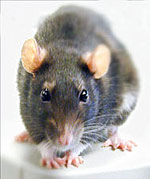
Leptospirosis A group of infections transmitted to humans by rats and other animals.Caused by Leptospira bacteria, and carried by rats and foxes and excreted in their urine. Infection is usually transmitted to humans by contact with contaminated water or soil.
The infection causes flu-like illness. However in its most severe form, leptospirosis may be life threatening. The disease can affect anyone who comes into contact with contaminated water, such as swimmers in contaminated lakes or reservoirs.
 Asthma
Asthma

In the past bacterial diseases were a major cause of death; today most serious infections can be treated with antibiotics. [1]
Typhus A serious rickettsial infection transmitted to humans by lice, fleas or mites. Caused by living in overcrowded unhygienic conditions. There are 3 main types of typhus, all of which are caused by different types of rickettsial bacteria.
Epidemic typhus is transmitted by body lice, usually in overcrowded conditions and has resulted in hundred of thousands of deaths inn times of war or famine. Today the disease is rare except in some tropical areas of Africa and South America.
Endemic or murine typhus, is rare and is transmitted to humans from rats by fleas.

Scrub typhus is transmitted by mites has been reported in South East Asia and India.
The first sign of infection with scrub typhus is a black scab over the site of the bite. In all types of typhus, flu-like symptoms may develop in 1 – 3 weeks of infection, followed a few days later by a widespread blotchy pink rash. In severe cases, delirium and coma occur. If the disease is not treated dangerous complications such as pneumonia or kidney failure are likely to develop.
Diagnosis is from symptoms or by blood test. Treatment with antibiotics is usually effective. Without treatment the disease can lie dormant in the body for years before being reactivated.
Typhoid and Paratyphoid Infections caused by salmonella bacteria that result in high fever followed by a rash.
Typhoid and paratyphoid are almost identical caused by the bacteria Salmonella typhi and S. paratyphi respectively. The bacteria multiply in the intestines and spread to the blood and other organs, such as the spleen, gallbladder and liver.
The disease is spread through infected faeces and most commonly occur in areas where hygiene and sanitation are poor. Infection is commonly due to food or water contaminated by unwashed hands.[ 2 ]
Symptoms appear 7 – 14 days after infection and include;
• Headache and high fever
• Dry cough
• Abdominal pain and constipation usually followed by diarrhoea.
• Rash of rose coloured spots appear on chest, abdomen and back.
Both infections can lead to intestinal bleeding and perforation of the intestines.
Diagnosis is by testing blood or faecal samples. The disease is usually treated by antibiotics in hospital. Symptoms usually subside in2 – 3 days after treatment is begun and full recovery within a month.
Even with treatment the bacteria are excreted for about 3 months. People who do not have treatment may become lifelong carriers of the bacteria, even though they appear to be healthy, and transmit the infection to others.
 Typhoid Mary aka Mary Mallon (born: 23-Nov-1869 died: 11-Nov-1938), was the first person in the United States to be identified as a healthy carrier of typhoid fever. Over the course of her career as a cook, she infected 47 people, three of whom died from the disease. Her fame is in part due to her vehement denial of her own role in causing the disease, together with her refusal to cease working as a cook. She was forcibly quarantined twice by public health authorities and died in quarantine.
Mallon died at the age of 69 due to pneumonia (not typhoid) after a stroke six years earlier which left her paralysed. However, an autopsy found evidence of live typhoid bacteria in her gallbladder[ 3 ]
Typhoid Mary aka Mary Mallon (born: 23-Nov-1869 died: 11-Nov-1938), was the first person in the United States to be identified as a healthy carrier of typhoid fever. Over the course of her career as a cook, she infected 47 people, three of whom died from the disease. Her fame is in part due to her vehement denial of her own role in causing the disease, together with her refusal to cease working as a cook. She was forcibly quarantined twice by public health authorities and died in quarantine.
Mallon died at the age of 69 due to pneumonia (not typhoid) after a stroke six years earlier which left her paralysed. However, an autopsy found evidence of live typhoid bacteria in her gallbladder[ 3 ] Boil it, cook it, peel it or forget it
◊ If you drink water, buy it bottled or bring it to a rolling boil for 1 minute before you drink it. Bottled carbonated water is safer than uncarbonated water.
◊ Ask for drinks without ice unless the ice is made from bottled or boiled water.
◊ Eat foods that have been thoroughly cooked and that are still hot and steaming.
◊ Avoid raw vegetables and fruits that cannot be peeled. Vegetables like lettuce are easily contaminated and are very hard to wash well.
◊ When you eat raw fruit or vegetables that can be peeled, peel them yourself. (Wash your hands with soap first.) Do not eat the peelings.
◊ Avoid foods and beverages from street vendors. It is difficult for food to be kept clean on the street, and many travellers get sick from food bought from street vendors [ 4 ]
Good hygiene is the best protection against infection. Several vaccines are available and if you intend travelling to a developing country, immunisation may be advisable. However be aware vaccines are not 100% effective.

Typhoid brought down Ancient Greeks
Modern DNA analysis of ancient dental pulp suggests that typhoid fever caused the plague that helped end the Golden Age in Athens. Scientists say the DNA sequences resembled Salmonella enterica servovar Typhi, the organism that cause typhoid fever.
Up to one-third of Athenians are thought to have died from the plague that spread from Ethiopia, Egypt and Libya in 430-426 BCE. One of the most prominent victims was the Athenian leader Pericles.
The plague is thought to have changed the balance of power between Athens and Sparta, ending Athenian dominance [ 5 ]
Note: In the past bacterial diseases were a major cause of death. Today most serious infections can be treated with antibiotics [ 6 ]
|
Cholera An intestinal infection that causes profuse, watery diarrhoea. Cholera typically occurs in epidemics and has caused millions of deaths over the centuries. It is due to the infection of the small intestine by the bacterium Vibro cholerae. Usually associated with poor sanitation, cholera can spread through contaminated water or food.

The illness starts suddenly, 1 – 5 days after infection, with vomiting and profuse watery diarrhoea. In some cases fatal dehydration develops.
Treatment: Cholera is usually diagnosed from the characteristic "rice water" appearance of the diarrhoea. A faecal sample may be checked to confirm diagnosis. Urgent hospital treatment is needed to replace lost fluids and minerals, which are given orally or intravenously. Antibiotics may be given to reduce the risk of passing the infection to others.
Cholera vaccines are relatively ineffective. In regions where cholera may occur, good hygiene is the best protection. Diphtheria A throat infection that causes breathing difficulties. Diphtheria was a common cause of infant death until immunization became routine. In this disease the bacterium Corynebacterium diphtheriae multiplies in the throat and may release toxins into the blood. The infection is usually transmitted through airborne droplets from coughs or sneezes of infected people.
Symptoms develop in 1 – 4 days after infection and include;
◊ Sore throat
◊ Fever
◊ Swollen lymph nodes in the neck
◊ In many cases a grey membrane grows across the throat, causing breathing difficulties
If diphtheria is not treated, bacterial toxins may spread in the blood and cause potentially fatal complications such as acute heart failure and paralysis.
Treatment: Diphtheria may be diagnosed from the symptoms, but a throat swab is taken for confirmation. Most people recover if treated immediately with antibiotics and antitoxin injections. Routine immunization in children and boosters in adults provide protection against the disease.
Leprosy also known as Hansen's disease. An infection that affects nerves and skin,
 causing numbness and disfigurement. Leprosy is a long-term infection caused by the bacterium Mycobacterium leprae, which damages the skin and nerves. The limbs and face in particular may be affected. Infection is thought to be transmitted by airborne droplets produced when an infected person coughs or sneezes and through skin contact. Contrary to popular belief the disease is not easily transmitted from person to person. Only people who live in prolonged close contact with an infected person are at risk of infection. The disease is most common in Asia, Africa and South America.
causing numbness and disfigurement. Leprosy is a long-term infection caused by the bacterium Mycobacterium leprae, which damages the skin and nerves. The limbs and face in particular may be affected. Infection is thought to be transmitted by airborne droplets produced when an infected person coughs or sneezes and through skin contact. Contrary to popular belief the disease is not easily transmitted from person to person. Only people who live in prolonged close contact with an infected person are at risk of infection. The disease is most common in Asia, Africa and South America.Leprosy develops very slowly, the first symptoms appearing 3-5 years after infection. Initially nerve damage causes numbness of the skin on face, hands and feet. The affected skin may become thickened and discoloured. Leprosy is only infectious while these early symptoms are developing. Lack of sensation may lead injury or even loss of fingers and toes.
Treatment with antibiotics for up to 2 years prevents further nerve damage and reduces areas of thickened skin. However nerve damage that has already occurred is irreversible.
Plague A serious infection carried by rodents and transmitted
 to humans by flea bites. Plague is the result of infection by the bacterium Yersinia pestis. During the Middle Ages the disease caused widespread epidemics, one of the largest was the Black Death of the 14th century, which killed over 25 million people in Europe. Today small outbreaks occur in Asia, Africa and South America and a few cases each year in USA. The plague is unknown now in Europe.
to humans by flea bites. Plague is the result of infection by the bacterium Yersinia pestis. During the Middle Ages the disease caused widespread epidemics, one of the largest was the Black Death of the 14th century, which killed over 25 million people in Europe. Today small outbreaks occur in Asia, Africa and South America and a few cases each year in USA. The plague is unknown now in Europe.People given immediate treatment with antibiotics usually make a full recovery. However if treatment is delayed, the disease is frequently fatal.
SepticaemiaAn infection also known as Blood Poisoning, in which bacteria multiply in the bloodstream. It affects mainly children and elderly people. It is common for bacteria to enter the bloodstream in small numbers through breaks in the skin or through the mouth when the teeth are brushed.

The bacteria are usually destroyed by the immune system and cause no symptoms. However if bacteria enters the bloodstream in large numbers from a major source of infection, such as a kidney infection, blood poisoning can result.
Septiceaemia can develop as a complication of almost all types of serious infectious diseases. The infection is more likely to occur in people with reduced immunity due to disorders as diabetes mellitus or HIV infection, or treatment with chemotherapy.
If you are suspected of having sepacaemia you should be admitted to hospitalfor blood tests to identify the bacterium causing infection. With appropriate antibiotic treatment most people make a complete recovery.
Tetanus A wound infection caused by a bacterial toxin, that produces severe muscle spasms. The toxin causing tetanus is produced by the bacterium Clostridium tetani,
 which lives in the soil and in the intestines of humans and other animals. If the bacteria enter a wound, they multiply causing an infection that acts on the nerves controlling muscle activity. The condition, called lockjaw, is rare in developed countries because most people have been immunized.
which lives in the soil and in the intestines of humans and other animals. If the bacteria enter a wound, they multiply causing an infection that acts on the nerves controlling muscle activity. The condition, called lockjaw, is rare in developed countries because most people have been immunized. Symptoms usually appear 5 – 10 days after infection. Fever, headache and muscle stiffness in the jaw, arms, neck and back are typical. As the condition progresses, painful muscle spasms may develop. In some cases the throat or chest wall is affected leading to breathing difficulties and possible suffocation.
Treatment is with antitoxin injections, antibiotics and sedatives with anti-anxiety drugs to relieve muscle spasms. Mechanical ventilation may be necessary to aid breathing. If treatment is delayed, tetanus is usually fatal.
To reduce the risk of tetanus, you should thoroughly clean wounds, especially those contaminated with soil and treat with antiseptic. Deep puncture wounds which are especially likely to become infected, should be seen by your doctor.
Vaccination against tetanus, usually given in early childhood is highly effective. Boosters should be given every 10 years to maintain protection.

Leptospirosis A group of infections transmitted to humans by rats and other animals.Caused by Leptospira bacteria, and carried by rats and foxes and excreted in their urine. Infection is usually transmitted to humans by contact with contaminated water or soil.
The infection causes flu-like illness. However in its most severe form, leptospirosis may be life threatening. The disease can affect anyone who comes into contact with contaminated water, such as swimmers in contaminated lakes or reservoirs.
Beware of a Wee Rat Problem: E-mailed accounts of death and disease caused by rat urine on soda cans are mainly bogus. While most of these types of scares contain a whiff of plausibility, there is nothing inherently toxic from urine or faeces from healthy rats. Excretions from a sick rat are a different matter and may be what this Urban Legend is addressing. In the U.K. about 8 cases are reported each year. About 100 to 200 cases occur in the USA (half in Hawaii) according to the CDC [ 7 ] In November 1998 leptospirosis killed 8 people and hospitalised 100 in China. An outbreak of leptospirosis in Sichuan in which 6 people died in February 2014, shows that the disease spread by water contaminated with rat urine is far from eliminated in China. |

